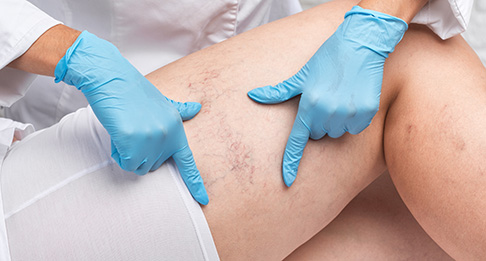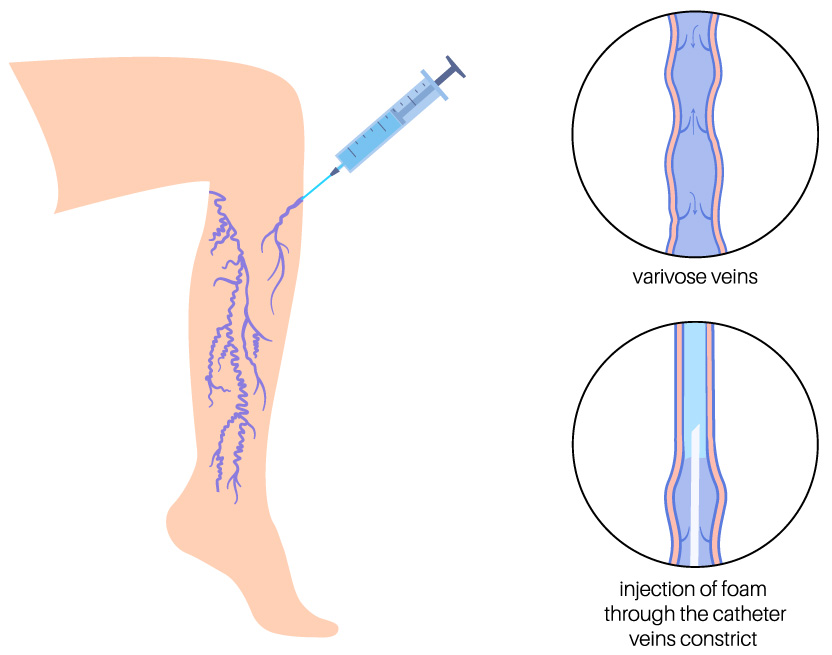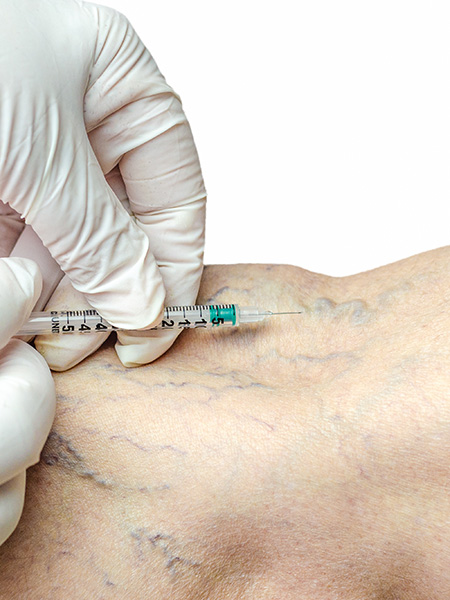Sclerotherapy

What is Sclerotherapy Used For?
People undergo sclerotherapy for varicose veins for a variety of medical, cosmetic, and comfort-related reasons:
Medical Reasons
Sclerotherapy is often performed to treat symptoms caused by chronic venous insufficiency or malfunctioning superficial veins, such as:
- Pain or aching in the legs, especially after standing or sitting for long periods
- Swelling in the lower legs or ankles
- Heaviness or fatigue in the legs
- Night cramps or restlessness
- Itching, burning, or throbbing along affected veins
- Skin changes, such as hyperpigmentation or eczema
- Venous ulcers, in more advanced cases
By closing off diseased veins, blood is rerouted to healthier ones, improving overall circulation and reducing venous pressure.
Cosmetic Reasons
Many patients seek sclerotherapy for aesthetic improvement:
- To eliminate or fade visible varicose or spider veins (telangiectasias, reticular veins)
- To achieve smoother, clearer leg appearance, improving confidence when wearing shorts or dresses
- To complement or maintain results after other vein procedures (e.g., radiofrequency ablation, VenaSeal, or phlebectomy)
Preventive or Maintenance Treatment
- Sclerotherapy can help prevent progression of venous disease if done early.
- Some patients undergo periodic sessions to maintain results and prevent recurrence, particularly if they have genetic predisposition or occupational risk factors (e.g., long standing hours).
Post-Procedure Follow-up or Adjunctive Use
- It’s frequently used as an adjunct after larger vein closures (RFA, EVLT, or VenaSeal) to treat residual branches or tributary veins.
- Helps complete treatment by targeting surface veins that weren’t addressed during thermal or adhesive ablation.
How is Sclerotherapy Performed?
Sclerotherapy is a proven procedure that has been in use since the 1930s. It is a very common procedure that usually takes less than an hour.
Sclerotherapy is performed by:
- First, your practitioner will clean the area of your skin
- Next, an injection of a solution (usually a salt solution) is given directly into the vein and your practitioner will massage the area to help distribute the solution
- The solution irritates the lining of the blood vessel and then, the vessel collapses and sticks together
- Without the flow of blood, your body’s tissues will start to absorb the vein
- Your problematic vessel turns into scar tissue and your body reroutes the vein’s blood flow to healthy veins instead
- There is no more blood flow to the troublesome veins
- Your vein fades completely over the next few weeks or months

What Should I Know Before Sclerotherapy?
Your specialist will evaluate you to determine what treatment option is right for you. There are different types of injections used in sclerotherapy depending on your needs.
Before the treatment, be sure to talk to your doctor about your medications. You may need to stop taking anti-inflammatories or avoid alcohol and nicotine.
Wear loose-fitting clothing and avoid lotion on the area prior to sclerotherapy.
Throughout the procedure you will be as comfortable as possible. If you feel uneasy about any part of the procedure, talk to your doctor about options to relieve your anxiety.
Most find the injections relatively painless, though you might experience a small amount of burning, tingling, or discomfort. The injections often contain a small amount of numbing agent to minimize any pain related to the procedure.
If a vein is difficult to see from the surface of the skin, your vein surgeon can also use ultrasound guidance to visualize the vein and treat it with sclerotherapy.
After Sclerotherapy
Most patients are able to return to their normal activities immediately after the procedure is complete.
After sclerotherapy you will be able to drive yourself home and resume your regular daily activities. Walking is also encouraged to help avoid blood clots.
Other recommendations after sclerotherapy include:
Avoiding hot baths or saunas
Showers are allowed, but water should be cooler than usual
Avoiding direct exposure to sunlight
Wearing support garments to compress the treated vessels for about two weeks
Avoiding aspirin, ibuprofen or other anti-inflammatory drugs for at least 48 hours
Washing injection site with a mild soap
What to Expect Moving Forward
Sclerotherapy works for many patients, most seeing spider veins respond in three to six weeks.
Some larger veins may take longer, like three to four months. If the veins respond to the treatment, they will not reappear.
Less than 10 percent of people do not respond to the injections at all. If this is the case for you, another solution can be tried after discussing your situation with your doctor.
Usually, 50 to 80 percent of the injected veins are eliminated with each session of sclerotherapy. It may take more than one session. If needed, you may return for injections, especially if new veins continue to appear.
Types of Sclerotherapy
Liquid Sclerotherapy Injections
- Use a liquid solution to penetrate the veins
- Liquid injections mix with your blood to trigger the formation of scar tissue

Foam Sclerotherapy Injections
- The foam solution is similar to the liquid alternatives, but it contains air or another chemical to give the solution a voluminous texture
- Foam injections remain separate from your blood
- Foam displaces your blood so that it can’t flow through your veins
- Contains less sclerosing agent (the chemical that causes the death of the vein)
- A good option for patients who want to eradicate their veins with minimal chemicals
- Foam solution usually covers a larger surface area, it usually works better for large or long veins
Both options of sclerotherapy are proven effective. Talk to your doctor about which is right for you.
Next Steps
Give us a call at 888-783-0111 to talk about sclerotherapy. We can help evaluate your veins and also check for any underlying blood vessel disease.
We can talk to you about your options, so you can feel confident moving forward with sclerotherapy.
